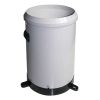KISTERS TB7 Tipping Bucket Rain Gauge
Features
- Integrated bird guard
- Minimal maintenance required
- Robust design for all environments
- Free ground shipping
- Expedited repair and warranty service
- Lifetime technical support
- More
Overview
The KISTERS TB7 is a new generation high-quality tipping bucket rain gauge for measuring rainfall and precipitation in remote and unattended locations. TB7 is a reliable ‘low-cost’ device with very good accuracy across a broad range of rainfall intensities.
Design
The TB7’s tried and proven design ensures long-term, accurate and repeatable results. It is manufactured from high-quality, durable materials, ensuring long-term stability in the harshest of environments. The enclosure and base consist of robust UV-resistant ASA polymer, and fasteners and filter are made of stainless steel.
Mechanics
TB7 provides a finger filter that ensures the collector catch area remains unblocked when leaves, bird droppings and other debris find their way into the catch. The TB7’s base incorporates two water outlets at the bottom allowing for water collection and data verification.
Resolution 0.2 mm, 0.5 mm, 0.01”
Range 700 mm per hour
Accuracy Resolution
0.2 mm 0.01“ 0.5 mm
Flow rate 0-200 mm/hr +/-5 % +/-5 % +/-5 %
Flow rate 200-500 mm/hr NA NA better than -8 %
Alternatively: Individual accuracy +/-2 % at any set intensity
specified by the user, calibration required.
(Please note: additional costs for individually calibrated units)
Enclosure and Base UV-resistant ASA
Pivots Ground sapphire pivots
Bucket Teflon impregnated injection moulded
Dimensions Height: 310 mm (H)
Catch: 200 mm diameter
Mass 2.1 kg
In The News
Three Decades of Research at Acton Lake
A multi-disciplinary team at Miami University, Ohio, has been studying the environmental change at Acton Lake for over three decades. Using three different NexSens buoys over this time, the team has an incredible archive of data that is helping build a picture of Acton’s past, present, and future. Until recently, a NexSens CB-50 buoy was used alongside other environmental monitoring at Acton Lake. In May 2025, the Miami team deployed a new XB-200 buoy , future-proofing their ongoing monitoring using real-time buoy systems. Acton Lake, a small hypereutrophic reservoir in southwest Ohio, covers 2.4km² and has a maximum depth of about 8m. The dam was built in 1956, and the lake has a large agricultural watershed.
Read MoreSource Water Monitoring in Albany, New York: Tracing Water Quality throughout Tributaries
Thousands of US cities pull their drinking water from natural source waters like reservoirs, rivers, and streams, making overall watershed health a key consideration for water providers. In Albany, New York, the Albany Department of Water and Water Supply delivers drinking water to over 100,000 residents as well as monitors and manages the larger drinking water supply watershed. Hannah Doherty, Environmental Specialist at the Albany Department of Water and Water Supply , spends her days working with a small team to monitor the drinking supply and the connected water bodies. Doherty explains, “We’re the first to encounter the water that ends up being the drinking water.
Read MoreWildfire Prevention in the Sierra Nevada Region with the Yuba Watershed Institute
Though recent wildfires have sparked new conversations about wildfire management and response, groups like the Yuba Watershed Institute have been monitoring the forests and water resources of the Sierra Nevada region for decades, managing approximately 5,000 acres of land with the Bureau of Land Management (BLM) and about 7,000 acres in private land partnerships. The goal of the Institute is to work with local communities and land agencies to improve watershed and forestry management through informed practices and public outreach. The goals of the Yuba Watershed Institute are three-fold: Improve the ability of fire suppression agencies like the California Department of Forestry and Fire Protection ( CAL FIRE ) and the US Forest Service.
Read More















